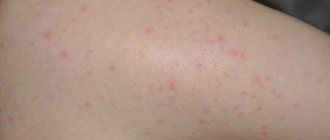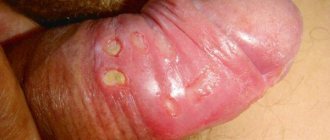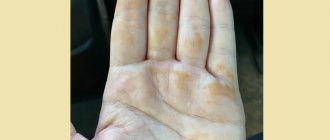Heat rash in children is the body's reaction to excess heat and sweat, resulting in small red blisters on the skin that cause itching and burning. It is localized mainly on the neck, back, chest, armpits and buttocks. Skin rashes appear mainly in newborns, because they have smaller sweat pores, and the glands and excretory ducts are still immature.
If the rash does not go away within 3-4 days and is accompanied by fever, vomiting, diarrhea or lethargy, the child should be seen by a doctor. Also dangerous are symptoms such as loss of appetite, the appearance of pus in blisters and enlarged lymph nodes. A child's heat rash is recognized during a visual examination. For differential diagnosis, the patient is referred to a dermatologist.
Types of heat rash in children
Small excretory glands, due to the secretion of sweat, take part in thermoregulation processes. The secret is represented by an aqueous solution that cools the body when the permissible temperature increases, stressful situations and physical activity. In addition to small sweat glands, the body has apocrine ducts - large ducts that have no connection with thermoregulation.
This is an extremely common disease that develops in almost every child. This is due to the anatomical and physiological features of the structure of sweat glands in children.
Miliaria are classified according to the depth of blockage of the sweat duct, clinical and histological signs. What does prickly heat look like in a child, depending on the form of the disease:
- Crystalline. Ductal obstruction in the superficial part of the epidermis with retention of sweat in the subradicular layer. They are tiny transparent bubbles in the form of drops that burst under slight pressure and are accompanied by peeling. This type of heat rash usually does not cause pain or itching and is considered the mildest form of the disease. If the cause is eliminated, the rash goes away within 2-3 days.
- Red. The most common form of miliaria, it causes blockage of the ducts in the middle layer of the epidermis. It affects the deep layers of the skin and is therefore accompanied by the development of an inflammatory process. It is characterized by the appearance of itchy and irritating (pricking) papules at the mouths of the sweat glands. Miliaria rubra can last up to 2 weeks.
- Pustular. Is a secondary infection or an aggravated inflammatory response of the vesicular pattern of miliaria erythematosus. It is characterized by micro-pustules, which are located mainly on the nose, scalp and forehead. This form of the disease can occur after other dermatoses, such as eczema.
- Deep. Develops within the dermal papilla, at the dermoepidermal junction, with sweat retention in the dermis. This leads to the appearance of papules that are larger and deeper than those of miliaria rubra. Papules are usually painful.
Based on the extent of the affected areas, localized and generalized forms should be distinguished. In the first case, the rash is located on certain parts of the body (or on one), in the second - over the entire surface of the skin.
Classification of the disease
There are four main types of miliaria, which differ in the nature of the rash, the duration of development and the severity of symptoms:
- Crystalline. It is accompanied by the development of a blistering rash, which most often appears on the head, behind the ears, and on the neck. Other localization of rashes is also possible. 2-3 days after the appearance, the blisters dry out and begin to peel off. Since irritation is not accompanied by inflammation or infection, the crystalline form is the simplest and most harmless.
- Red. A more complex type, in which sweat acts on the skin for a longer time and, accordingly, causes more severe irritation. A rash in the form of small inflamed tubercles provokes slight swelling and is accompanied by itching, burning, and discomfort. Lasts about two weeks.
- Miliaria alba, or vesiculopustulosis. With this type, blisters with a whitish or yellowish filling appear on the skin. When the bubble bursts, it leaves behind a light coating. The presence of color in the bubbly fluid indicates that the rash is accompanied by an infection, often staphylococcal.
- Deep. In most cases, prickly heat causes only superficial damage to the skin. With a deep form of pathology, the deep layers of the skin are affected. The disease is accompanied by blisters filled with light contents, which resolve or burst spontaneously.
Reasons for development
Heat rash in children develops against the background of predisposing factors of an exogenous and endogenous nature. Internal causes are associated with the physiological characteristics of the child’s body and the functioning of the skin. The skin of children is softer and thinner - it has a richer blood supply and is distinguished by a diffuse arrangement of sweat glands.
The pH value is close to neutral - 6.7, so bacteria that fall on the surface are not neutralized. Thermoregulation functions are imperfect due to immaturity. For this reason, there is no possibility of responding to temperature fluctuations with spasm or dilation of blood vessels.
Miliaria in infants also occurs due to external factors:
- failure to comply with hygienic skin care requirements;
- daily bathing using alkaline soap;
- lack of air baths (24-hour wearing of diapers);
- use of inappropriate clothing (without taking into account the ambient temperature);
- excessive wrapping in the hot season;
- viral diseases with fever;
- room temperature exceeding 22 degrees.
Of particular importance is the use of low-quality children's cosmetics made from synthetic raw materials. Oily creams, which are not absorbed into the epidermis, have a negative effect on the condition of children's skin, contributing to the disruption of heat transfer and skin respiration. In this case, the secretion produced by the sweat glands does not evaporate, but creates favorable conditions for blockage of the excretory ducts.
At risk are children with diabetes mellitus, seborrheic dermatitis, rickets and skin allergies. Children who are bottle-fed and overweight are at risk. Miliaria also develops against the background of infectious diseases (pneumonia, tonsillitis, chickenpox, ARVI), in which feverish conditions and excessive sweating are noted.
Why are infants most susceptible?
Miliaria can develop at almost any age, however, most often this type of skin rash occurs in infants.
The following features contribute to this:
- Children's skin is much thinner than adult epidermis;
- There are many small vessels on the skin of newborns, which leads to the rapid spread of the slightest inflammatory formation;
- The newborn quickly overheats, this is due to the poor functioning of the sweat glands;
- The skin of newborns is very sensitive and reacts to sweat;
- The child's skin does not produce pigment, so the reaction to thermal influences is the formation of prickly heat.
The epidermis of newborns is very sensitive and when various irritants in the form of dust come into contact with the skin, protective functions may manifest themselves in the form of increased sweating, which leads to the formation of prickly heat.
Symptoms and signs of the disease
In mild cases, symptoms may be absent, with the exception of a rash. In advanced cases, accompanied by complications and infections, the clinical picture is complemented by an increase in body temperature to 38 degrees, the appearance of ulcers, ulcers and light plaque, the formation of an unpleasant odor and weeping cracks, as well as a deterioration in general well-being.
What does prickly heat look like in newborns, depending on the type of disease:
- Crystalline. Characterized by the formation of fluid bubbles and vesicles (papules) that burst easily;
- Red. It manifests itself as reddened bumps, itching or tingling in the affected area.
- Pustular. Characterized by the presence of fluid-containing vesicles that become inflamed and filled with pus (pustules).
- Deep. Sweat leaks from the sweat glands into the skin and results in hard, red lesions that resemble goosebumps.
This condition is not contagious and cannot be passed from one person to another. Favorite places for prickly heat are the back of the head, behind the ear, neck, back, upper chest, buttocks, inguinal folds and the area along the hairline.
The bubbles have a diameter of 1 to 2 mm and are localized scattered or grouped. They are filled with clear liquid or surrounded by an inflammatory halo. Symptoms fade or progress during the day, depending on the care of the child and the temperature of the external environment.
If the elements of the rash merge, weeping lesions appear. In the case of an itchy rash, the child experiences severe discomfort, which is accompanied by whims, deterioration of sleep and severe anxiety. Hyperemia and swelling of the skin are characteristic of advanced cases when a fungal or bacterial infection occurs.
Treatment of heat rash
Hot or humid conditions are the main risk factors for heat rash in children. When treating prickly heat in children, it is necessary to take general measures to reduce sweating and blockage of the ducts:
- maintaining the temperature in the room;
- wearing breathable clothing (made from natural fabrics);
- bathing in a weak solution of potassium permanganate and chamomile decoction;
- use of high-quality creams and lotions.
Miliaria crystalline does not require any treatment. It is enough to follow preventive measures for the child’s condition to improve. Be sure to change the diaper every 3 hours, after washing the baby. Air baths when changing clothes are also important.
How to treat miliaria with medications? Therapy is aimed at reducing inflammation, and therefore mild to moderately effective corticosteroids may be used for 1 week. It is also recommended to use antiseptic solutions (chlorophyllipt, furatsilin). Treatment of prickly heat in a child with the development of the pustular form of the disease requires the use of remedies for bacterial infection - local antibiotics. Immunostimulating therapy is prescribed in rare cases.
The miliaria erythematosus is a benign lesion, but can be quite unpleasant. For severe itching or burning, in addition to the preventive measures mentioned above, you can use lotions with calamine, menthol or panthenol.
Before treating prickly heat in a child with medications, you should consult your doctor. Skin lesions are extremely common in infants, and some may resemble a rash. Avoid using creams and lotions on your own, as well as talcum powder, as these substances can cause further clogged pores, worsening symptoms.
What is not recommended to do?
In some cases, prickly heat may worsen as a result of improper parental actions:
- You should not allow additional irritation to the site of inflammation or try to “clean” it by squeezing out pimples and nodules. This usually leads to infection of the miliaria;
- Do not try to treat the site of inflammation with brilliant green or iodine! Such methods lead to chemical burns;
- You should not give your child even the mildest antibiotics or antiviral drugs without a doctor’s testimony;
- Do not use moisturizing ointments and creams! They will interfere with normal air circulation on the skin and will also retain sweat, which will only worsen the child’s condition;
- Do not wipe or dry irritated areas of the skin with dense and sudden movements. You should use only a soft towel and make gentle blotting movements so as not to mechanically irritate the miliaria.
Disease prevention
Taking some preventative measures is the easiest way to avoid heat rash in an infant. Your child will be able to cope with sweating better as they get older. Until then, try to buy clothes made from natural fabrics, observe temperature conditions and use only high-quality care products. Symptoms of prickly heat in an infant disappear after proper hygienic care is provided.
Prevention of heat rash in a baby:
- In hot weather, avoid swimming in very hot water.
- Dress children in clothes made from natural fabrics (cotton absorbs sweat and provides ventilation).
- Cool baths can help soothe the itching and tingling sensation caused by heat rash.
- Maintain a cool ambient temperature.
- If it is hot and very humid, use air conditioning to keep the temperature fairly comfortable. This approach prevents excessive sweating and reduces heat rash symptoms on the neck, face and back.
In most cases, there is no need to visit a doctor or take medications. It is enough to bathe the child in a timely manner and avoid overheating to prevent the accumulation of sweat on the skin. Semi-synthetic and synthetic materials that do not provide normal air exchange are unacceptable.
When to see a pediatric doctor
The presence of the following symptoms clearly indicates the need to urgently contact a qualified medical professional:
- In addition to skin rashes and redness, swelling and swelling began to appear;
- Despite all the measures taken, the rash lasts for 3 or more days, there is no positive dynamics;
- The liquid in the bubbles changed color and an unpleasant odor appeared;
- The baby is constantly bothered by itching and pain;
- The baby's temperature has risen.
All of these signs indicate a high probability of developing an infectious disease, but in order to confirm this, it is necessary to undergo certain tests that only a pediatrician can prescribe.











